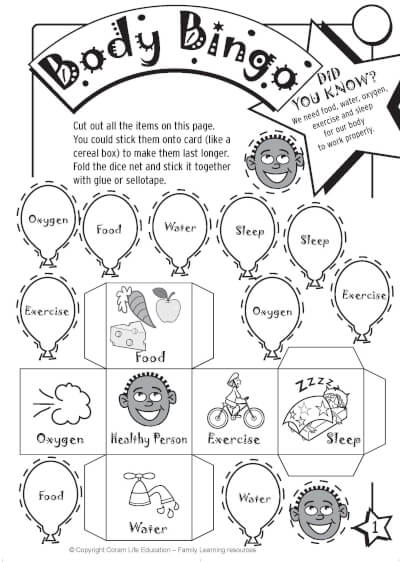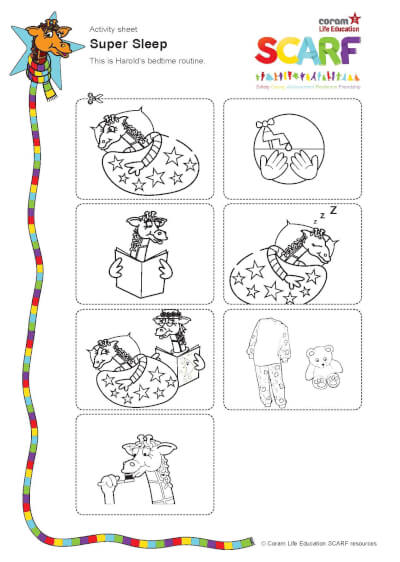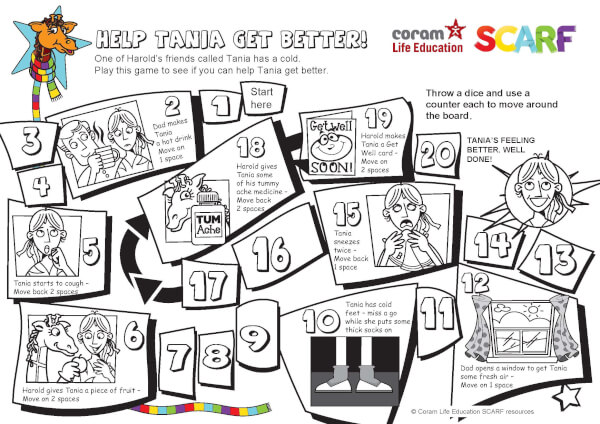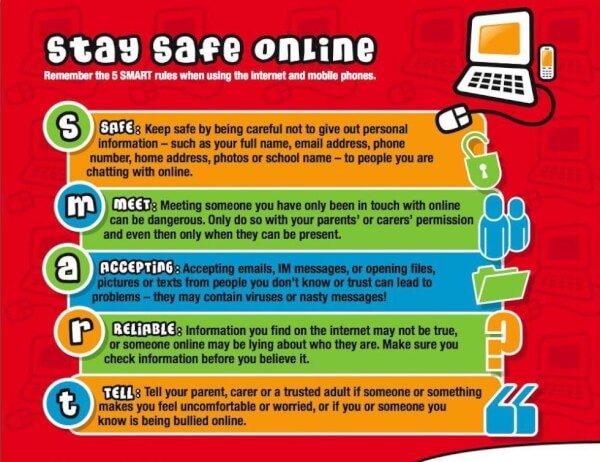SCARF at Home: Keeping Myself Safe - activities for 5-7 year-olds
What your child will be learning about
- The things we need to keep healthy, including healthy food, exercise and sleep
- How to keep safe when ill - including medicine safety
- Staying safe online
What you can talk about, together
Here are some starter questions for you to talk about;
- What different things help to keep us all healthy?
- Which physical activities do we like doing together?
- What are our favourite different healthy foods?
- Why is sleep so important?
- What can we all do to help us sleep long enough and to sleep well?
- What can help us when we're ill? (Try to think of things other than medicines first of all, such as rest, sleep, drinking plenty of water.)
- How can medicine be helpful?
- When might medicines be harmful?
What you can do together
Activity 1 - Body Bingo
Our body needs five things, every day, to keep it healthy:
- Food
- Water
- Oxygen (in the air we breathe)
- Exercise
- Sleep and rest
Play the Body Bingo game to create a healthy person.
If you don't have a printer, just draw the Body Bingo boards (page 2) and use a dice - give each number one of the 5 healthy things, e.g. 1 = Food, 2 = Water etc. And 6 = A Healthy Person. You have to roll a 6 to start! Use coins for counters!

Click on the picture to make it bigger or to print it.
Activity 2 - Super Sleep!
Begin by talking about why sleep is important. Here are some ideas to get the conversation started. Sleep helps our body to...
- Grow
- Feel awake and able to concentrate
- Recover after a busy day
- Repair - our body repairs things when we're asleep
- Remember - sleep boosts our memory
- Sort out problems or worries - our brain keeps working when we're asleep and can help is to work out the answer to problems that might be bothering us!
To help us get enough sleep it helps everyone (and that includes adults!) if they have a good bedtime routine.
Find out how much sleep young people need, from the NHS Live Well website, here.
Next, talk about the things we do before going to bed (e.g. stop looking at screens - TV, tablet, phone etc.) put nightwear on, brush teeth, wash hands and face or have a bath, bedtime story, cuddle teddy bear or blanket etc.
Look at the picture of Harold the healthy giraffe's bedtime routine and together, cut out the pictures of bedtime routine activities, then stick them onto a blank sheet of A4 paper in the correct order for their own bedtime routine. If you don't have a printer, draw the pictures, putting them in the right order.
Your child can draw additional activities and include these if they want to.

Click on the picture to make it bigger or to print it.
Activity 3 - Medicine safety
Start with a discussion about the things we can do to help us get better if we're unwell, e.g. rest, sleep, drink plenty of fluids.
Then discuss these questions about medicines:
- What is a medicine? (Something which can be given to help make somebody feel better. A medicine often only helps treat the symptoms of an illness, rather than the illness itself. The body is pretty good at recovering from most illnesses by itself!)
- How do people take medicines? (Tablets that are swallowed, liquids that are measured in a special spoon and swallowed, creams or ointments that are rubbed onto the skin. Less commonly inhaled - breathed in.)
- How would someone feel if they took too much medicine? (They could feel very poorly.)
- How would someone feel if they took the wrong medicine? (Again they could feel very poorly.)
- Why do adults need to look after medicines? (To make sure they were kept in a safe place and taken properly.)
- Who would normally look after your medicine at home? (Parent/carer.)
Play the game Help Tania Get Better!
If you have a printer, make a copy of this board game (you could stick it onto card, to make it stronger), then find a dice, plus some counters to move round the board - coins will do.
If you don't have a printer, play the game on the screen. Use a dice to move around the on-screen board. Your child can be given the job of keeping note where each of you is on the board!

Click on the picture to make it bigger or to print it.
Activity 4 - Stay safe online
Start with a conversation about all the different ways that computers help us (e.g. we can do our shopping, find out about the weather, play games, read stories, watch TV etc.)
Then discuss how we have to be careful when using computers. Explain to your child how we should never share information about ourselves with people we don't know. And if they ever see or hear anything scary when playing on a computer they should tell you - or another grown-up at home, straight away.
Here are lots of activities that your child will enjoy and at the same time learn really important things about how to keep safe online. These resources have been specially developed for children aged 5 to 7 years old by the National Crime Agency's Child Exploitation and Online Protection Unit.
Click on the link CEOP activities for 5-7 year-olds, here for lots of simple, 15 minute activities to do with your child, helping them to stay safe online.
Childnet International also have useful information for parents and carers to help you teach your children how to keep safe online. Their Stay Safe Online SMART rules poster is a useful starting point for talking about online safety.

Click on the picture to make it bigger or to print it.

